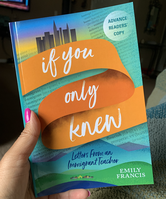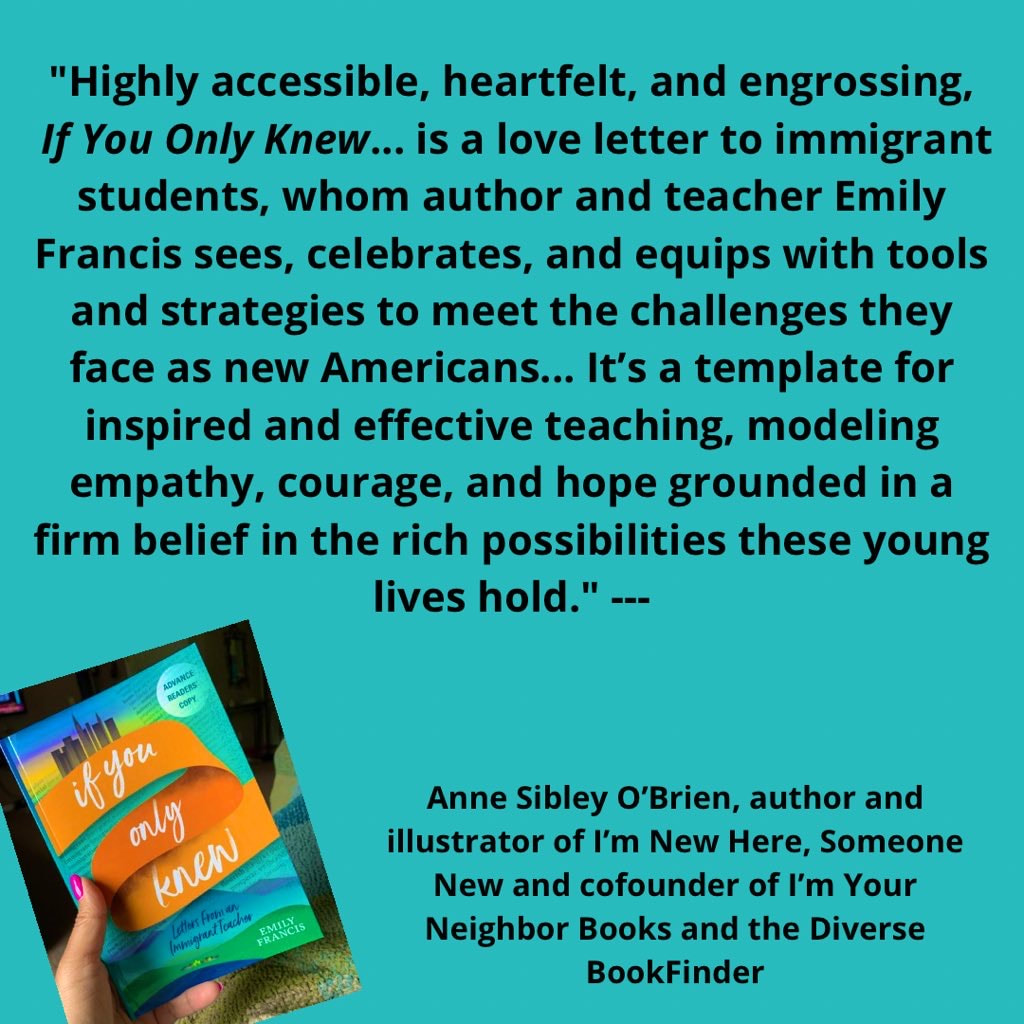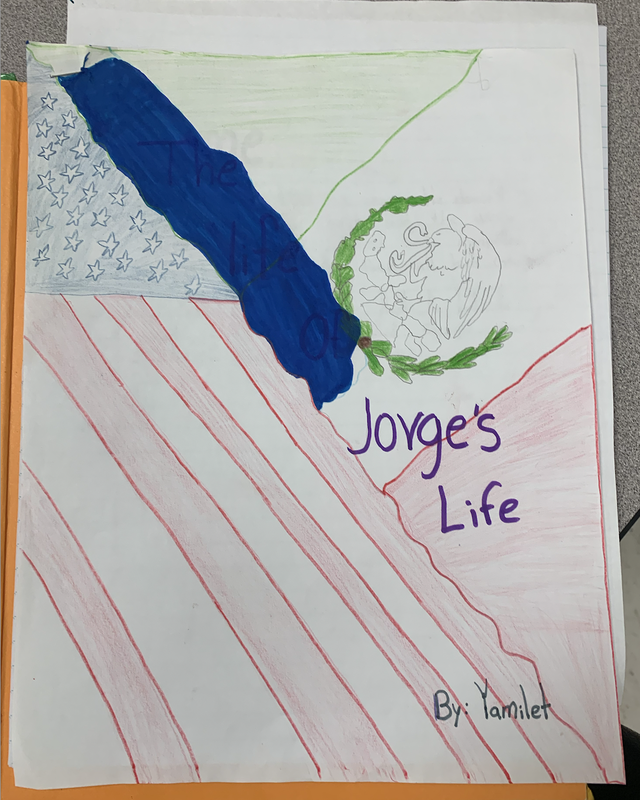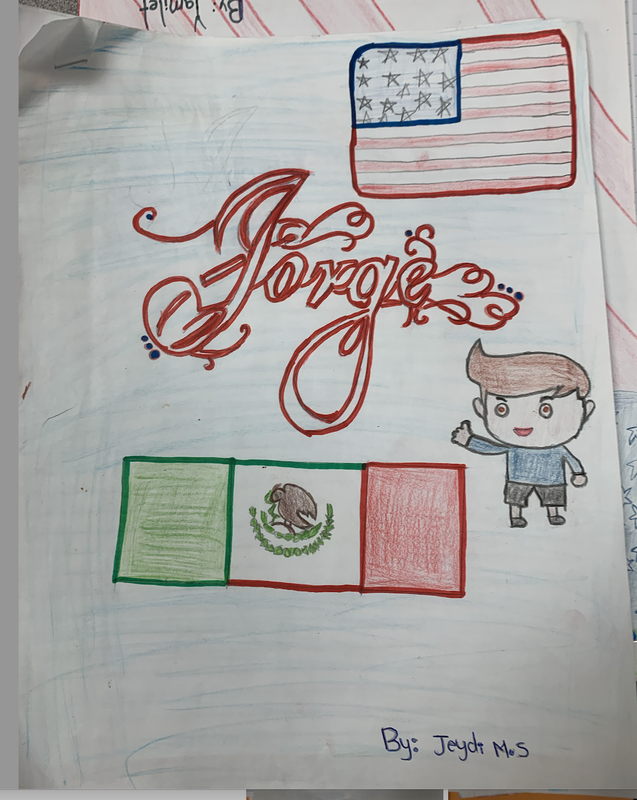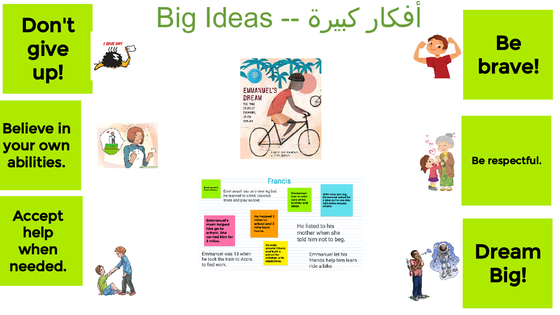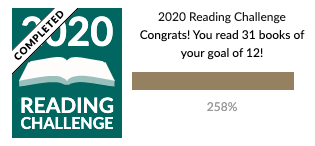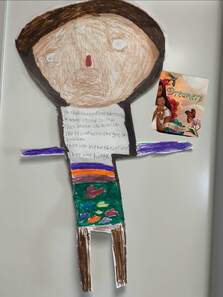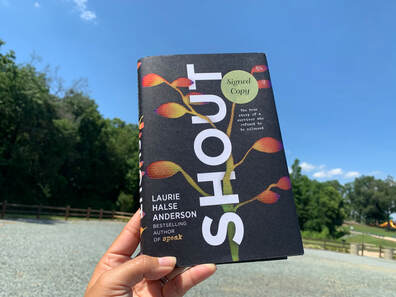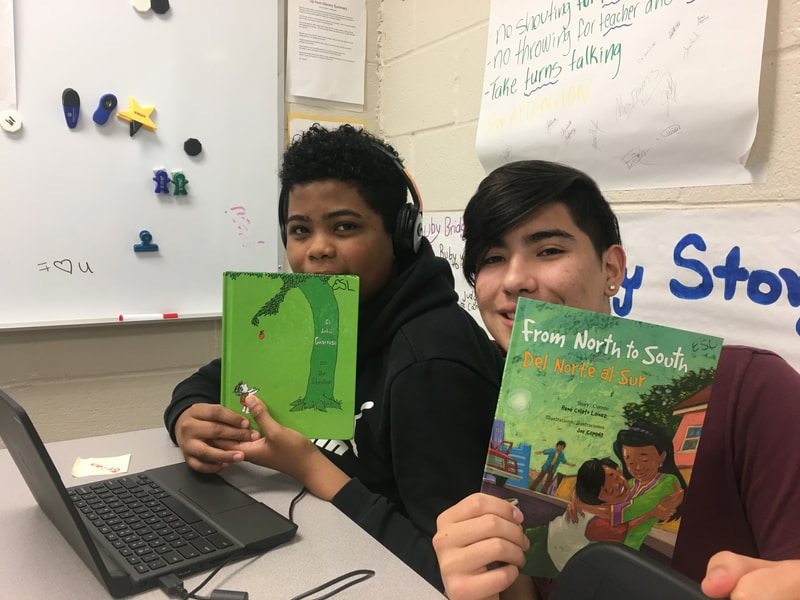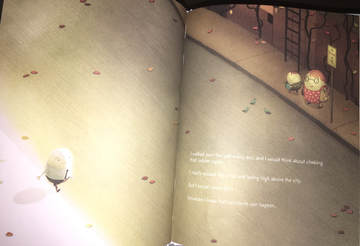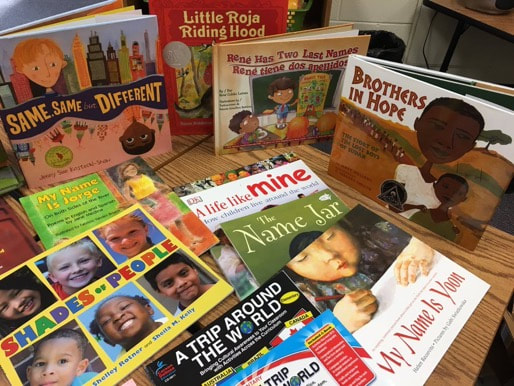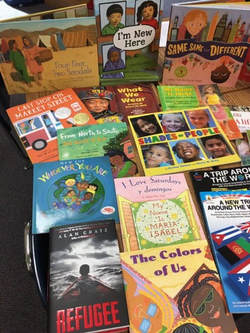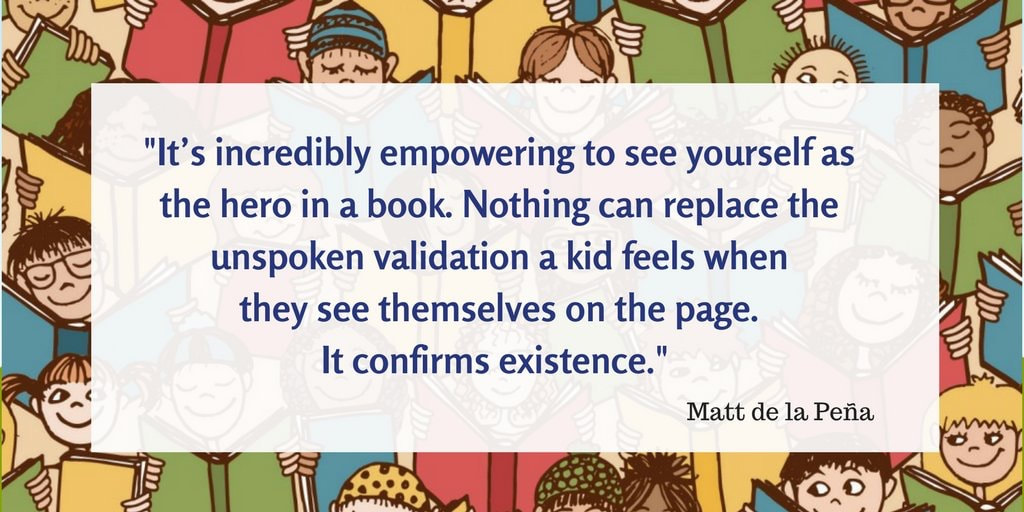|
I had the honor and the privilege to attend and present at the 2022 Immigrants Student Success Virtual Conference. If you can, check out the many different recorded sessions that can help you provided support to your immigrant students. The conference covered:
My Session: Identity Affirmation Through Literature, Language and StorytellingLet me know if you watch my sessions! I'd love to hear your takeaways!
Thank you for reading!
1 Comment
In May, I was thrilled to share with you the amazing cover of my book If You Only Knew: Letters from an Immigrant Teacher, soon to be published by Seidlitz Education Publishing.
During the month of June, advanced readers' copies (ARCs) were sent out to selected readers. I don't have the words to describe the feeling when I opened the package and saw my book for the first time. It was an excitement that words cannot explain. Holding the book in my hand brought tears to my eyes. I can't wait for the world to read it. Some readers received a hard copy of the ARC, others received an e-book. Some readers I selected just because I've followed their work and knew they would enjoy the book and provide great feedback. Other readers were selected by the publishing company or the our marketing company. I'd have to say that PR by Books is doing an amazing job helping me promote the book and making sure the world know about this great book. Just look at this great Author's Page and the NetGalley page where you can read some reviews. Reviews
I am honored and humbled to read these great reviews. All these authors are highly respected and are authors I personally admire and have learned from. I appreciate them taking time to read and review my book.
Kirkus Reviews
NetGalley and Goodreads Reviews
If you are a NetGalley member, you can request an e-book the book and provide your review. If you're on Goodreads, please, add this book to your "to-read" list! Click here to read more.
It feels my heart with so much joy to see my friends and network tweeps reading my book and providing such heartfelt reviews and comments. I was thrilled to see THE Valentina Gonzalez ,author, speaker, and professional development facilitator, make time to read my book. Thank you to all my friends and family for your support.
As always, thank you for reading and staying connected. Be sure co add your name to this book launch form so you are informed when you can order the book!!
Click HERE! My Name Is JorgeI have to be transparent and share that poetry is not one of my favorite genres to read or to choose as a mentor text to teach my students. Of course, once in a while, I come across some amazing poems that shake me to my core - like "My Name is Jorge: on Both Sides of the River" by Jane Medina I LOVE using this book towards the end of April to celebrate Poetry month but also to begin introducing our last unit of the school year - Moving Stories. I cannot remember how I came across this book, but what I do remember is turning every page and finding myself reflected in every word. I'd say that this is one of the first books I came across in my first year of teaching and it impacted so much in the material and resources I began using to teach my multilingual students. What fascinates me about Jorge's story is that each poem is a window for the reader to learn about an event and experience in Jorge's life. Each poem is at a kid-friendly level that children can understand and learn from Jorge and his family. Lesson #1Unfortunately, I only own two copies of this book so I had to get creative to have students read the book. I started by analyzing the book first and deciding which poems are the core of Jorge's story. Even though all the poems are fantastic, I knew that reading the whole book would've been overwhelming for my newcomers since there are 27 poems. The poems I chose are: My Name is Jorge Invisible Why Am I Dumb? The Busy Street Dirty Words Mexican Dummy Tine The King of the United States Ants-On-A-Log My Paper Suspended Men Don't Cry The Test Packing Once I had selected the poems I wanted to have students analyze, I made a list of themes I noticed were highlighted by each poem. The themes I came up with were Language, Food, Representation, School, Immigration, Name, Family Divided, Unfairness, and Back to Mexico. I made a copy of the poems I selected (along with the Spanish translation) and I placed them all around our classroom. The idea was to have students get up and go around the room reading the poems. The assignment was to read each poem and think about what the poem was mostly about. Each student was given a sticky notepad to share how each poem is related to one of the themes listed by the teacher. I had placed the themes on chart paper on the board so students knew what each theme was. Many of the themes were topics we had discussed during previous lessons. I also left a chart paper with a question mark for students who wanted to brainstorm their theme. Lesson #2My students learned a lot about Jorge and his family - As we were discussing what Jorge and his family had experienced in Mexico, throughout their immigrant journey, and here in the USA, I noticed that it was becoming easy for my students to retell the events and connect with Jorge's life. So, the follow-up lesson was to take the sentences we had written on our sticky notes and the knowledge we had gained about Jorge's life to write all about Jorge's life in a narrative format. I put together a packet for each student to begin a story draft. Each packet contained a cover white sheet of paper and ten notebook sheets of paper - one for each theme in the story. After students created a cover for their story about Jorge, they were instructed to retell Jorge's story using the sentences they created from each poem and for each theme. We talked about how a story must have a beginning, a middle, and an end - so as they picked the order of their sentences, they were to consider what might've happened when and in what order. For example, the poem about Jorge's name is. a great poem to introduce Jorge. Next, poems that share about this childhood, migration, school, family, etc. All books were different since everyone had a different perspective of the poems and added their perspective. Each student's book about Jorge had at least 10 pages and was in chronological order. Once the story drafts were ready, students took turns to meet with me to make sure the book was in the correct order. We also discussed ways to make the book interesting and with our perspective and connections added to it to make it interesting. Lesson #3Students' stories were fantastic and I didn't want them to just remain a draft - I knew that these stories needed to go out to their world to read. These stories are such a great example of how powerful a story can be - how important it is for students to read books that reflect and affirm their existence.
I've always used the website WriteReader to encourage my students to publish their writing for the world to see. This, of course, was the first resource I thought about when thinking about publishing my students' stories. Here are their stories. I encourage you to make time to read them and perhaps you can also find a personal connection with these stories. Yency's Jorge's Story Alanie's Jorge's Story Jeydi's Jorge's Story Yamilet's Jorge's Story Miriam's Jorge's Story Alhassan's Jorge's Story Alhussein's Jorge's Story Enrrique's Jorge's Story Alexander's Jorge's Story Jhosselyn's Jorge's Story Luis' Jorge's Story
You heard it say...and I'll say it again - Teachers, work smarter NOT harder!!!
After my newcomers finished creating sentences based on their sketches of the story "Emmanuel’s Dream: The True Story of Emmanuel Ofosu Yeboah", (SEE LESSON HERE), I wanted my students to do something with their hard work. THIS lesson here gave me a GREAT idea for our next lessons! This lesson extension lead us to discuss "Big Ideas" found in the story, analyze visible and invisible traits, and compare and contrast ourselves to Emmanuel. Big Ideas
The "Big Ideas" were not a difficult process to explain since I presented them through a Jamboard, so my students quickly translated the ideas and were able to understand them. We sure practiced reading them in English and found sentences we had created to match each "Big Idea".
The list of "Big Ideas is in the lessons shared above on page #4. The handout is to compare and contrast, but I only had them complete the "Emmanuel" part. The matching details supporting each idea had to come from the sentences students had already created; so, there wasn't any extra work to do besides analyzing the sentences and placing them on the corresponding "Big Idea". 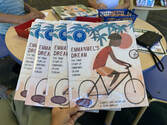
One of my favorite and most impactful picture books I enjoy using to teach my newcomers is - "Emmanuel's Dream: The True Story of Emmanuel Ofosu Yeboah" by Laurie Ann Thompson
Emmanuel Ofosu Yeboah's inspiring true story and the fantastic illustrations in the book are a great tool to not only teach English as a second language but also encourage our students to embrace who they are and believe in their abilities and potential. The first thing I did was check with my public library to see how many books were available to check them out and use in our class. Eventually, I'll buy my own class set!!!
I LOVE highlighting and posting on Twitter and Instagram my students' work. Just like they are proud of their work, I'm proud of it too. So, last week, right after posting about my newcomers' fantastic writing, I received a question from a follower. She asked: "How are you able to get newcomers to produce that much written language? I am super curious!"
This question surprised me because I've worked with newcomers for years, and I don't have a problem getting my newcomers to produce written work - unless, the student is a SLIFE (students with limited formal education). -- But even like that, I've figured out ways for newcomers to produce written work that demonstrates their learning...see this lesson here. Anyway, I thought I'd share here how my newcomers' written work was scaffolded so they demonstrate their full potential. Picture Book Project
In my opinion, picture books are the best text we could use with newcomers that will provide the understanding and the language they need to be able to retell the story.
I started by sharing with my newcomers a list of guiding questions we were to use to help us understand and retell the story.
How much do you appreciate literacy? How do you encourage literacy in your family or with students? How do you demonstrate your love and passion for literacy?
These are questions that I would have not been able to answer during the first 15 years of my life. I attended school while living in Guatemala but I didn't appreciate how much the literacy I was learning in my home country was going to be the core and foundation to everything I have accomplished here in the USA. Read more about my journey here! From the year I started working as a teacher assistant in 2004 to today -- Literacy has been something I've learned to embrace and enjoy. The foundations of the English language I learned sitting in a first-grade classroom as a teacher's assistance helped me understand how language works to make sense of words and use them to comprehend text and to write our own story. As a friend, parent, teacher, sister, and aunt, I'm always looking for ways to encourage young children to read and write. One way I do this is by celebrating literacy on days that are nationally or internationally recognized - For example, there is National Multicultural Books Day (1/29), World Read Aloud (2/3), Library Lovers Day (2/14), National Write Your Story Day (3/14), Childre's Book Day (4/2), Día de los libros (4/30), National Book Lovers Day (8/9), National Read a Book Day (9/6), International Literacy Day (9/9), I Love to Write Day (11/15), etc!! That's why tomorrow, September 8th, 2021 we are celebrating literacy in our English as a Second language classroom. I finished reading my last book of 2020 around noon on December 31st, 2020. My last book was the awesome middle grade book Everlasting Nora by Marie Miranda Cruz (even my 7-year-old loved it).
I really loved and enjoyed every single book I read in 2020. In fact, what makes me so excited is the fact that I was able to not just meet but surpass my 2020 reading challenge!! Of course, this was not always the case. I've tried meeting my reading challenge for years (since 2016) and I had never been able to complete it...until 2020.
National Hispanic Heritage Month is by far a favorite time of year in the USA. From September 15th - October 15th this country honors, celebrates, and recognizes the contribution and influence of Hispanic Americans to USA culture, history and more!
This year, I decided to share a video challenging my #PLN and followers to do the following:
After sharing my challenge, I had a few friends sending me messages accepting the challenge and sharing their findings. It was wonderful to see friends embracing this wonderful celebration.
I also began sharing all my Hispanic Heritage Books (at least the ones I had at home). Every day from September 15th to October 15th I shared a 30 second video of a book that highlights and honors Hispanic culture. I shared picture books, middle grades books, young adult books. I shared my books on Twitter, Instagram, and Facebook. All of these videos were curated and uploaded it to my Youtube channel. If you have read any of these books, share with me how you're using them with your students. If you are adding any of these books to your booklist/bookshelf let me know. I'd love to connect and discuss how to use the book with your students.
If you are on Instagram and would like to check out the curated stories, check it out HERE!
Thank you for reading!
This post is featured on the Re-Imagening Migration website. Find article here: Did you know that students are NEVER too old to enjoy a picture book? This article here tells you more. Even adults can learn from picture books - I do! The book Dreamers, written and illustrated by Yuyi Morales, is a stunning picture book with an amazing story about an immigrant mother and her baby immigrating to the US. While discussing it with our newcomer students, I began placing sticky-notes everywhere with all the ideas and thoughts that were rushing through my mind. Here is what I was thinking: Packing Our Culture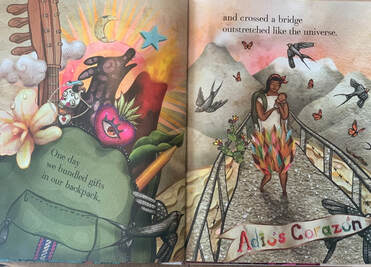 Dreamers book by Yuyi Morales Dreamers book by Yuyi Morales I was 15 years old when I was asked to pack-up a backpack with a couple of outfits and whatever else I could fit in and carry with me on a journey from Guatemala to the USA. I remember looking around the room and packing a few photographs and recuerditos (keepsakes) I didn't want to leave behind. I do not doubt that many immigrants experience this moment when they have to decide what to pack and bring along their migration journey. Besides packing the essentials, many of us pack something that will remind us of the world we are leaving behind, representing our country, homeland, and believes. Just like we pack-up objects, we also pack-up our identity within us and hold on to it as tight as possible because we know it is what makes us who we are. The things we pack-up within us are experiences, thoughts, feelings, beliefs, family, foods, music, culture, heritage, and more. All this builds our individuality. Yuyi Morales narrates this personal experience perfectly in this image. We see how her backpack includes a jatana, a pencil, nature items, and Señor Calavera. If you follow Yuyi's Instagram account, you'd see how these objects represent her identity. Objects that she carried with her as she crossed over the Mexican border to come to the USA. And just like we see in her book, the objects that represented her identity were kept safe and packed up because they were being protected or perhaps they stayed packed up because she didn't feel like her individuality would fit in the new culture. In Dreamers, we see the characters trying to blend in and function in a new country and culture but with a substantial struggle to be who they are. I experienced this as well, and so do many immigrant students and individuals who come to the United States. While many of us love our home culture, our language, and everything about our heritage, society tells us that to function successfully, we must keep our background packed up and blend in the American culture and master the English language to be successful. For many of us, it'll be years and years till we realize that our culture, language, and heritage are valuable and core to who we are. For others, this realization will never happen - and heritage, language, and culture will be lost. To me, this is a sad reality that will hinder many generations. Opportunities to Unpack As an immigrant myself, I can tell you how intimidating it is to be yourself and unpack our background for all to see. You look around, and everything is new and different. You listen around, you and all you hear is the new language -- a language you don't yet understand. However, there are ways to embrace the differences while still appreciating what is packed within us and show them to the world. Here are a few of them:
Unpacked CultureHaving our culture and heritage unpacked is just the most wonderful feeling. How do you know your culture, language, and heritage is unpacked? - When you celebrate it, appreciate it, and embrace it. When you do not fear what others will say about who you are, how you speak, or what you're wearing. When you begin to find a place in your new home, you understand that we have more similarities than differences and contribute to society to create a beautifully diverse culture. As we were reading this book with my student, we both had different takeaways from the text. Yousef here was able to draw what he understood what was happening in the story, then retell the story using his own words. He was able to personally connect with several parts in the story and was very confident understanding it because the images speak so much. I am encouraged to write my takeaways because he did the same! If you have read this book and would like to share your takeaways with me, please share them with me. I'd love to hear about your experience with this amazing book. Or if there is another book that would share these same ideas, I'd love to know of it.
Remember YOU matter! Your culture matters, your language matters, your heritage matters. So, showcase it...display for all to see and appreciate it. Thank you for reading! I am so excited to share with you all about this fantastic book I just finished reading (twice). Efrén Divided by Ernesto Cisneros - This is a beautiful family story - not only the main character Efrén Nava is highlighted, but also his parents and the entire family. Efrén is a fascinating young boy who at a very early age finds himself having obligations at home that go beyond his responsibility. The story begins setting a stage of a very humble Hispanic family living with very little resources but strongly united. Efrén's Amá goes looking for a job, while her children are in school, when she gets caught up in an ICE raid and is deported back to Mexico. Efrén is heart-broken but at the same time, his heart was ready for this news since he understood that his parents were in danger since they were undocumented in the US. He quickly begins taking responsibility for his twin brother and sister Mía and Max. I Love Efrén's attitude towards his family. Without complaining and without asking why he jumped in and contributed however he could to support his family and continue providing a sense of consistency and normalcy for his siblings. Throughout the story we see the family's strength to keep the family together - Apá works countless hours and goes above and beyond to provide for his family and find ways to bring Amá back home. I have to say how much I LOVE the way Ernesto honors Hispanic families and culture throughout the story. Amá's deportation hurt the entire family - and we see how every one of them kept on pushing and functioning and planning regardless of how they were feeling.
It is a story that many students will identify with - whether is because they are separated from their parents or maybe because they are carrying on the same responsibilities and obligations Efrén is having to do. This is a story all teachers, principals, social workers and guidance counselors need to read. I was able to connect with the story because I experienced a lot of the things the family goes through - but if you have NEVER experienced anything like this, it would give you a needed perspective to better understand your students. I do not doubt in my mind that a lot of students in our classrooms are experiencing things at home that do not feel comfortable sharing with anyone at school; hence knowing about these topics would give teachers that understanding and the knowledge they need to advocate for students. During July, I participated in the #ELLchat_bkClub Twitter book chat where we engaged in conversation with this book. It was so exciting to hear from other teachers reading this book and see how they react to certain parts of the book. I also LOVED engaging with the author who participated during our entire book study. Link to resources for our book-study Because I believe this book needs to be used in schools - whether is for bookclubs or guided/strategy reading groups or school group discussions, I made these chapter notes and questions as I read the book. Feel free to use them! If you create any more resources for this book, I'd love to hear from you. So far all I have are questions and topics for discussion but I would love to see educators creating an entire book study with activities for the book. Here's a great identity heart graphic organizer a book study participant created. Amy Sherman took the challenge in creating an identity map on Efrén Nava and it is just fabulous. This would be something amazing to have our students create too. You can find a printable version of the graphic organizer here.
These are the questions we used for discussion during our book study on #ELLchat_bkClub. If you need an editable version of the questions pdf documents above, you can access them here.
This book is without a doubt a 5 starts book that middle schoolers and HS students would love. I'd love to hear from you if you have read it or if you decide to read it. There are many topics to discuss and I'd love to engage in conversation with you about this book. Author Ernesto Cisneros is very active on Twitter so connect with him and ask any questions you may have. Thank you for reading! Book #1
I was so excited to read this book that I pre-ordered it and received it 2 days after it was released. As soon as I found out that this story was about 3 Guatemalan teenagers - I knew I had to read it.
Of course the story does not disappoint! We Are Not From Here by Jenny Torres Sanchez is a hard book to read just because the journey Pulga, Chico, and Pulga (3 main characters) go through are VERY difficult. This book tells the raw journey of 3 teens who ride La Bestia (a monster train) to immigrate to the USA and their journey will stay with you long after you finish the book. As a Guatemalan and immigrant myself - I was able to identify with the characters which is something I long for my students to do when reading our class books. I am going to be so excited to share this book with my students...especially when the Spanish version is released!!! You can find my full booktalk/review of this 5-Star book here on my YouTube channel!
Book #2
I read this book over a weekend! I usually take much longer to read books because I read in between errands, parenting, cleaning, cooking, etc. THIS book, however, was a book I couldn't put down.
Laurie Halse Anderson's book SHOUT - is a book that that will make you want to shout and stand up for those who have experienced or are experiencing sexual abuse, rape, and/or harassment of any type. I would not even think twice about having this book on my class bookshelf for HS students to read. Not only will this book encourage and empower readers to stand up and speak up agains sexual assaults, but also will ignite the desire to want to know more about this topic and advocate for those who are hurt. Check out my review on my YouTube channel here!
I was super excited when the author Laurie Halse Anderson shared my BookTalk - see it below!!
If you read any of these books, please share with me on the comments below. I'd love to hear from you and your thoughts on any of these books or other books written by these authors.
Thank you for reading and keep on reading!!
The Bilingual/ESL Department at Region 10 ESC in North TX holds an annual symposium for their 500+ educators. This year, due to the COVID pandemic, the event was help virtually.
I was honored and humbled to be invited as their 2020 Symposium 'Power Of Unity' keynote speaker. I was so excited to connect and meet so many passionate educators who are working hard to provide their very best for all students. Day 1Keynote Presentation
The keynote presentation was on June 23rd and it was a way to kick-off the symposium - teachers had a long day of sessions to attend right after the keynote.
My presentation title was 'Shifting from Statistics to Stories' The presentation was streamed LIVE so you can find the recorded version on my YouTube channel below. **This post appeared originally in Seidlitz Education on April 21st, 2020.** It doesn’t happen as often as it should, but when it does, it is the most amazing feeling one can experience. That moment when you’re reading a book and you see your life and family experiences reflected on every single page. That moment when you see text and images intertwine on a page to bring forth cultural validation and acceptance. That moment when you close the book and cry tears of happiness because you realize that stories are so much deeper than you ever thought. I experienced all this and so much more the day I read Sometimes… by Hugo Ibarra and John Seidlitz. (video of me reading the book aloud for International Children’s Book Day.) Sometimes… is just the book we need right now. Ibarra and Seidlitz share with us a story in which immigrants’ experiences are legitimized, one that opens doors for connections and much-needed conversations. It is a story that made me think about how experiences and family stories don’t have to be forgotten. And about how significant it is when stories are shared, because they validate what is core in our existence and our hopes for what is to come. Sometimes… is a story of hope. A story of courage and strength. A story of a family who worked together through difficult circumstances to make their dreams come true. And even though sometimes things don’t go as planned and changes need to happen along the way, we see the characters rising through it all. We see Andrés and Clara holding tight to the hope offered by their mother and teachers. A hope that helps them get through every situation that comes their way. The International Children’s Book Day theme for 2020 was “A Hunger for Words”, and as much as I identify with this phrase, I also believe there’s a hunger for cultural understanding — a hunger for identity and individual acceptance. Children all over our nation deserve to open a book and see their families’ experiences and languages heard and represented. Through the lens of an unaccompanied and undocumented immigrant, an English language learner, and an educator, I closely analyzed each page of Sometimes… and wrote down a few essential points at which the book authentically reflects many of our students’ experiences.
Last week I found out about International Children's Book Day - a wonderful worldwide celebration.
I immediately started looking into it - If you know me...you'd know that I am passionate about children's books. I love picture books. I used them when I taught elementary with students in Kindergarten through 5th grade and now I use them with my newcomer high school students. There's just something magical about a children's books & picture book. I've used them to teach all genres and I've found that students connect with these books and encourages them to learn more. So, as soon as I found out that International children's Book Day is celebrated on April 2nd, 2020 - I started brainstorming about what book to focus on. Of course, all my cultural and diverse background book collection is in my classroom and there was no way I was going to be allowed in the building to get some. So I started digging through the books I have at home found a book author John Seidlitz sent me. I had not taken the time to read it so I started reading it...and...Oh...EM...Geeeeee! I started crying while reading it. I couldn't believe there was such an amazing book on my bookshelf and I have not read it!!! In Stories That Sparkle Powerful Conversations blog post, I shared a lesson I started with our SIFE (Students with Interrupted Formal Educations) ELs. This lesson led to another wonderful week where students created a wonderful presentation to show the rest of the class. All our newcomer ELs are expected to present their learning in our ESL class, of course, the bar remains high for SIFEs. Just like Kanako Suwa says, "Simplifying is GIVING UP, Scaffolding is BELIEVING. Simplifying is dumbing down/lowering expectations. Scaffold = same expectations and content + supports put in place to help Ss meet the expectations." With the understanding that these students are capable of more - I encouraged them to create their own book using the sentences they had formed from the book Dreamers. My students were very excited when they noticed that they were creating their own book using the information they understood. Both students were able to create and publish their own book but only one student had the strength to record the reading. It does take a lot of courage to do this knowing that your voice is being heard by others and you're not sure of yourself in the targeted language. So the platform I use to publish my students' stories is WriteReader. This platform is student-friendly and it can be used by students K-12. One of my students used the camera to take some pictures of the book that matched his text, another student took photographs of her own illustrations. Here's Yousef's book: DREAMERS (link includes voice/reading)
Here's Abril's book: DREAMERS
Both of my students did a great job and they are very proud of the work they accomplished.
You see, it really doesn't take much to help our English learners (and SIFE) to perform at their highest potential. If you choose to use this platform to publish your students' stories, please let me know! I'd live to share them with my students as well. Thank you so much for reading!
On August 15, I was supposed to attend and present at the Annual Global Education Summit in which by the way was in Concord, NC for the first time. This summit is organized by UNC World View department at The University of North Carolina Chapel Hill.
Unfortunately, and disappointingly, I missed it!! I had to go to TX to drop my son off and the day of my return to NC, my flights were canceled due to bad weather. What a bummer!! Anyway, I already had my presentation ready so I thought I would post it here for those who might be interested in using picture books to encourage and nurture a global mindset on students in K-12 education. Picture books are powerful pathways to learn, understand and embrace the world around us. My presentation description was as follows: Picture books are powerful pathways to learn, understand, and embrace the world around us. Characters’ experiences found in picture books can serve as mirrors that reflect and reaffirm students’ culture and experiences. Picture books serve as windows to an unknown world that nurtures empathy and passion for a global mindset. Incorporate picture books in lessons to support reading, writing, listening and academic discourse. Preparing our ReadingsI wanted to share our class experience for our second visit to W.M. Irvin elementary school. A couple of days before our visit, we discussed how important it is to be prepared when presenting, or teaching something new. I asked my students to reflect on my lesson delivery. I asked them to share how they know a teacher is well prepared or not so prepared for a lesson. Some were very honest and shared how they can tell when the teacher is thinking on an assignment and expects students to do what it's asked but there's very little support. However, when a teacher has everything printed out, written on slide or board, supports with clarity what's expected, then they perform much better.
After this conversation, I told them how they are becoming teachers when going to the elementary school because the little ones are learning from them. That being said, preparation to even read and ask questions is important. We then brainstormed what we could do to show up to the elementary school and be very well prepared. Here is what they came up with:
I was so proud of my students because they thinking as educators. They understood that preparation is key to not only feel prepared and ready but also to ensure that the student is supported enough to understand the story. So, our first step was to choose our book of choice. These are the books my students picked:
Personal experiences are powerful. My journey as a first-generation immigrant and a former English learner is now central to what I do. My personal experiences, coupled with my responsibilities as an educator, have helped me to embrace the role of an advocate and to create and establish a sense of culture that values students’ greatest gifts: identity and individuality.
When ILA launched Children’s Rights to Read campaign last fall, I immediately saw connections to my teaching philosophy and the role I can play in advocating for those rights. Children’s Rights to Read—10 fundamental rights ILA asserts every child deserves—is a campaign in which ILA aims to activate educators around the world to ensure every child, everywhere, receives access to the education, opportunities, and resources needed to read. As a high school teacher of English as a second language (ESL), my job is to analyze my students’ needs and to develop their linguistic and communicative competence in English in all language domains. However, my goal as an educator is to create meaningful learning experiences that serve as pathways for connection. I can create those experiences through the framework of Children’s Rights to Read During the summer of 2017, Refugee book by Alan Gratz was released. There was a huge buzz about this awesome book that I decided to get it. I even ordered several copies and shared with colleagues so we could all read it together. However, I had to stop reading it and put it away. I didn't stop reading it because I didn't like it; I stopped reading it because I found myself disoriented while reading it. You see, I am an English Learner (EL). English is my second language. As matter of fact, I've only had 3 years of high school and my college education here in the USA. Read here if you want to learn more. Even though I was compelled and excited to read this story, I found myself struggling to make sense of what was happening. I was getting frustrated. I was getting caught in small details, I couldn't remember the most important events, I was forgetting what I had just read and was unable to make connections between events. I TRIED! I KEPT READING! But I felt like I was wasting my time. So I gave up and put the book away. All year went by and I kept seeing posts about how awesome this book was and how everyone should be reading it. I felt bad and kind of embarrassed that I had not been able to read this wonderful book. However, reading 'Más Allá del Invierno' by Isabel Allende, entirely en Español, was super easy and refreshing to my mind. So, why did I have trouble reading Refugee, you might ask? Well, allow me to shed some light on the book's NARRATIVE STRUCTURE (text structure is the overall organization of the text). The novel alternates among three narratives that explore the lives of refugees in different decades and parts of the world. The book is beautifully written, and its narrative structure is brilliantly constructed...but, it threw me off and confused me as an English language learner. Isn't comprehension the purpose of reading? If so, if you can't read it, you can't comprehend it! Comprehension is the process of extracting or constructing MEANING!! Giving Refugee Book a Second ChanceThe #ELLchat_BkClub voted on reading Refugee over the summer of 2018. As matter of fact, I also voted on this book because I was still intrigued by everything I've heard about the story and I really wanted to read it. Guess what?!? I read it ALL in just 4 weeks! However, the only reason I was successful in completing the book was that I had support. You see, participating in a book club not only provided the accountability for my reading but also facilitated weekly discussions with other participants reading the same story. Dr. Katie Toppel, the book club moderator, provided weekly questions based on a given number of pages read, and that in itself, gave me the purpose for reading I needed to pause and reflect on what I had read. I was not just reading the words! I was making sense of the information and ideas. I was constructing meaning, and also retaining information. So this experience led me thinking about my ELs and thought about gathering some resources about this topic. Why Teach Fiction/Narrative Text Structures?The question should be, 'why wouldn't you teach narrative structures?'. If you want students to make sense of the text and build on ideas to construct meaning and to retain the information they're reading, then you MUST intentionally teach its structure. Students NEED a purpose for reading! The purpose of reading is COMPREHENSION. Again, if students are finding themselves disoriented while reading a narrative, they WILL NOT comprehend, construct meaning, and/or retain information. How to Teach Text StructuresELs, and all students in general, NEED explicit text structure lessons; they need tools to support them as they move throughout their reading whether is non-fiction or narrative text. I find this blog post on Cultofpedagogy.com by Jennifer Gonzalez loaded with resources on ways to teach text structures for non-fiction text. This "20 Strategies to Teach Text" is fabulous. It actually gives a great perspective as to why and how to teach text structures. Some key elements our students need to focus on while reading narratives are:
Here's an excellent list of printable graphic organizers provided by Fountas and Pinnell. The most important strategy we can teach our students is to PAUSE AND DISCUSS the text! MODEL, MODEL, MODEL how to think aloud while reading! Here's a great video that teaches how to model thinking aloud to increase comprehension. This "Think Aloud Checklist" is a great resource our students can have with them as they read and think about their reading. Introducing Fiction Text Structure with STORY looks like a fun way to teach this topic! Click here for more. S – SETTING T – TALKING CHARACTERS O – OOPS! A PROBLEM! R – ATTEMPTS TO RESOLVE THE PROBLEM Y – YES, THE PROBLEM IS SOLVED! In conclusion, the method you choose to teach your students 'Narrative Text Structure' doesn't really matter. What matters is to make sure students know how to navigate through challenging text formats to comprehend stories. Having the tools described above will increase reading speed, help retain content, and support with connections with incoming new information.
I would love to know if you use any of these resources or if you have any others I need to learn about. Please share comments below! Happy reading and thanks for reading my post! Do you know the Humpty Dumpty nursery rhyme? I'm sure you do! But, just in case you don't, this is how it goes: Humpty Dumpty sat on a wall. Humpty Dumpty had a great fall. All the king's horses and all the king's men, couldn't put Humpty together again. Interestingly, 2,500 people were asked to name their favorite nursery rhyme, and at no surprise, Humpty Dumpty is among the top 10 all-time nursery rhymes. However, this nursery rhyme only highlights Humpty's great fall and creates a sense of pettiness toward him because no one was able to fix him. My perspective on Humpty changed forever after reading After The Fall by Dan Santat. If you haven't read this book, go get it right now! This fantastic picture book is Humpty's story AFTER the fall...because he GOT UP again. His story is by far the most inspirational story I've ever read in children's fictional books. I was very emotional after reading it and I learned so much from it. Six Lessons I Learned from Humpty Dumpty...After the Fall Click image for Dan Santat's website Click image for Dan Santat's website
1. Embrace Failure The first lesson we can learn from Humpty is to embrace failure. He understands that everyone knows about him because of his "great fall". However, he doesn't define himself based on our perspective of him, but on what he believes of himself. He sees "the great fall" as an accident...and as an opportunity that changed his life. Can you say growth mindset?!? "There were some parts that couldn't be healed with bandages and glue." FEAR - the feeling Humpty had to embrace after the fall - and he embraced it like a hero. He began taking small steps in order to face his biggest obstacle...heights! 2. Know Your Purpose Humpty had a very clear picture of what his purpose was and who he was meant to be. He made sure he was always surrounded by what he was passionate about. His room décor shows what was in his heart and mind. And even though he knew that height was his weakness, he also understood that it was the very thing that was keeping him away from what he loved most - being where he belonged! Humpty walked by the wall every day! It was a daily reminder of his failure. But he wanted to be as close as possible to where he knew he was supposed to be. And every day he would think about climbing...perhaps planning his next steps...perhaps, thinking about what he would do once he gets back up where he belongs.
3. Enjoy the Moment He never gave up. Not even while all he had was walking by the wall and watching the birds fly up high. He settled on what he was able to do at the moment. He enjoyed the moment and made the best out of it. He actually thought, "it was better than nothing." As a matter fact, thinking about his future ignited in him an idea to get closer to his goal. You see, Humpty had his eyes fixed on his passion and goal. For him, it was fine to just do what he was capable of doing based on his abilities. Meanwhile, he was learning. Meanwhile, he was active. So this got me thinking, are my eyes fixed on my goals? Am I being active developing my skills to be who I am meant to be? Am I enjoying the moment and am I being faithful in the little bit I am asked to do right now? 4. Set Small Goals Humpty thought of a way of getting just a little closer to his goal. He started making paper airplanes so at least that part of him would make it to the top of the wall. As small as this small step might seem, he had to work day after day - try after try - until he was happy with this project. You see, having the motivation isn't enough to reach our goals. If we learn anything from Humpty, is the determination to complete small goals. He knew that what he was working on will one day pay off in his favor. Humpty didn't let cuts and scratches impede with daily work. He was determined to take it one step at a time. Applying this to our lives...what are we allowing to discourage us from achieving our small goals? What excuses do we have to stop developing the skills needed to function where we belong? Don't forget that goals without actions become just a wish! 5. Celebrate Small Accomplishments Accomplishing a small goal made Humpty happy. In fact, it gave him back the happiness he hadn't felt for a long time. Why? Simply because he understood the power of small goals. He celebrated the fact that he believed in himself. He knew what he was capable of. He knew it was close enough to his ultimate goal. It is so important for us to realize that it is OK to feel scared when drafting small goals. In fact, this is a good kind of fear! A fear of the unknown. However, it is exciting to know that reaching our goals will without a doubt give us a sense of accomplishment and a level of self-confidence that only we can give ourselves! Make sure to share your accomplishments with your loved ones. Use social media to share your accomplishments. Let your friends and family celebrate with you when you reach a goal. It's not about bragging...it's about the opportunity to inspire those who might need a little encouragement. 6. Determination Once again - Humpty is face-to-face with FEAR! The opportunity came for him to finally climb the wall and be where he belonged. He knew he had to climb that wall but he wasn't just afraid, he was TERRIFIED! At this very moment he has two choices: Walk away or step into an uncomfortable situation to finally be who he was meant to be. Humpty stepped forward! What made him stay and encouraged him, you might ask? Well, he started thinking about how hard he had worked to accomplish his small goals. He made a choice because he was empowered by his small goals and the sense of accomplishment he celebrated before. "I didn't look up. He didn't have to see the whole staircase - All he had to do was to take the first step! Halfway up he realized he was no longer afraid! What a powerful lesson we learn from Humpty; Progress is found outside our comfort zone, and it is through our uncomfortableness that we grow and develop the skills we need to be efficient where we belong. Making it to the top - where he always belonged, is where he became what he was meant to be! He made it so you and I can have a different perspective on him. He made it so that he can inspire us to reach our goals and celebrate where we belong. He made it so we can change our expectations of failures and those who fail. Humpty's grit and determinations are admirable! Let him be a hero to you and your students. Here is a great article I highly recommend: The Fear of Taking Risks Never Goes Away (Feel The Fear And Do It Anyway) For teaching lessons and ideas click here Thank you for reading!
"All the reading she has done had given her a view of life they had never seen." ~ Roald Dahl, Matilda
During the summer of 2017, I had the opportunity to travel to Germany with Go Global NC. I had an unforgettable experience! The biggest impact I had during this experience was the cultural differences and similarities I experienced in 10 days. Culture shock is not new to me! I came to the USA at the age of 15 and experienced as much culture shock as you can imagine. However, the sad thing was that I felt like as a newcomer student, I was somehow forced to put aside my own culture, beliefs, and values, in order to acculturate to the USA. Once I started school I stop reading and learning in Spanish; and I never had the opportunity to share my values and my Guatemalan culture with teachers and peers. I had the thought that my culture was not worth talking or reading about.
While visiting Germany's schools, I noticed as much diversity as we see in USA schools today. What shocked me, however, was how comfortable diverse students were sharing own culture and speaking their home language. Students would have book talks and you can hear 3-4 different language spoken at one time. Wow! What an eye-opening moment for me! I loved how students embrace who they are and how they value knowing and speaking different languages!! So I decided to take action. I want my English learners to not fall into the trap replacing culture while acculturating in the USA. Just because they are learning the language and living the USA doesn't mean they need to completely forget their roots and who they are. They need to know that their culture, language, and family beliefs are valued and matter. So I wrote two grants and both were funded:
Lessons
The following lessons can be for elementary grades K-5 and adjusted/extended as needed.
After reading the book out loud, students turned and shared with partners all the details the author mentions about similarities and differences. I had students create a T-chart with illustrations and labels as an anchor to share what we've learned. I could've created this chart myself, however, I believe in student empowerment...and having student created charts are just epic!
We used this chart as we introduced the next book. Connections are very important when introducing a new book or topic. This chart helped us predict and have discussions about the characters in our next book: Same, Same but Different.
These conversations that students were having was perfect since it prepared them to compare the two characters which are exactly what this book is about. The book is about Elliot who lives in America and Kailash who lives in India. They are pen pals who write to each other sharing their differences and similarities. After reading the book out loud, students turned and shared with partners all the wonderful things that the two characters have in common as well as their differences. At this point, students had so much language that they could've to continue sharing all morning long. Students also created a T-chart comparing the two characters:
As students were creating this chart, I asked to begin thinking about themselves and to come up with some things they had in common with one or both of the characters.
They were also asked to appreciate differences they had with one of the characters and share that as well.
If there is a book you must have as part of your classroom library, it should be I'm New Here. This book highlights exactly what students go through as newcomers in USA classrooms. In this book, you'll learn the struggles, the confusions, and the feelings that our language learners experience as they begin to acculturate in USA schools. However, what I love the most about this book, is the fact that it teaches us to highlight students' strengths and create a comfortable environment where students show their abilities. Maria, Jin, and Fatimah teach us a valuable lesson for all to learn...not just students...but educators as well.
Before we started reading I'm New Here, we discussed what it would be like to leave the USA and moved to India where Kailash lives and why? This image shows my first graders' responses using illustrations. This chart ignited a great discussion as we have already learned all about Kailash and his way of living. This was a great activity to activate background knowledge and make text to text connection. It was a great way to introduce our new book and begin predicting how the characters in our new story might feel because they had to leave their home countries to come to the USA.
Another great activity we did before we started our book was learning where our characters were from. We pulled out our world map and circled the three countries our characters were from. This is a great opportunity for students to learn a little more about different cultures. An extension to this map activity would be to learn all about: Guatemala, Korea, and Somalia. It is always a great idea to read the book aloud the first time without any interruptions. This is a strategy that teaches students to carefully pay attention to the story from beginning to end. After hearing the story, students turn and share with a partner all and everything they want to share the text. From character information to details - no specifics - just TALK about the text! For the second reading, students were told to pay very close attention to character change at feelings. They are told to observe how characters feel in the beginning of the story, in the middle, and how they feel once the story ends. Though this book is excellent to teach story sequencing, my focus was on understanding the character using the details found in the text. Students also had a written response assignment. They chose one of the characters and explained how he/she felt in the beginning of the story and compared to their feeling at the end of the story.
I was amazed how empathetic my students felt about each character. They were able to explain why students felt the way they felt and what made them change the way they each felt.
As students were sharing their individual written response, we created a classroom chart with all the details we learned about each character. I divided our chart paper into three parts to help students visualize the information need for each character.
While we were creating our chart I can tell some students were more into one character than others. I believe it was because they identified with the character's abilities or perhaps they felt a connection with the character's background and language.
This led us to begin analyzing the character of our choice. We cut our chart along the lines and made 3 groups. Students grouped according to their favorite character. The objective was to discuss all the details learned about their character and write a personal story about him/her using transitioning words - First, Next, Then, Last and to include details from the text as to how the character's feelings changed throughout the story and why. It was amazing how students engaged in this assignment and how enthusiastic they were to write all about the character of their choice.
If you want to read our students' books, follow this link and search the character of your choice: Maria/Jin/Fatimah. You won't be disappointed with their fantastic work!
The fascinating thing about this book is the ability to serve as a mirror for our students since they can identify with what the kids are doing; but also, as a window to expose our students the way of life in other parts of the world. We read the book the first time just to enjoy the rich text and the illustrations. But the second time, I had my students to think as they were listening, how they could make personal connections with the text. We also discussed analyzing the text structure - (sequencing of the story). After reading the book students turned and shared with a partner the connections they made with the actions that students perform in other parts of the world. Students also discussed the differences they observed comparing to their personal daily life. As a written response students were asked to illustrate or write what they do every day in the morning - at school - after school - and in the evening. This prompt follows the sequence students heard from the text.
Students shared with one another and grouped themselves according to similarities in what they do every day. So this gave me the idea to have them publish another book about what they do in a day!
If you want to read our students' books, follow this link and search One World One Day.
You won't be disappointed with their fantastic work!
I have shared our students' stories using my class twitter and facebook account and it is amazing the response we are getting. My students are so excited to learn more and write more! These are just some of the feedback we are getting and has empowered my students in so many ways:
Stay tuned for our next book... The Last Stop in Market Street by Matt de la Peña
Thank you for reading!
This post is featured on Confianza's website: Honoring Students' Stories: Identity Texts to Write and Diverse Texts to Read  We all know what a mirror is. We all have them and we all need them. Collins dictionary defines a mirror as a flat piece of glass which reflects light so that when you look at it you can see YOURSELF reflected in it. Sometimes we like what we see, sometimes we don't. Perhaps you remember the mantra of Snow White's evil stepmother: Mirror, mirror, on the wall, who's the fairest of them all? This evil queen had a mirror that will always reflect what she wanted to see...but on many occasions, it revealed things she didn't want to see so she'd do something about it. We can apply this same concept to books. Books as mirrors is not a new concept. The idea that a book reflects readers' identity and experiences was presented to us a few years ago. The problem I see is the lack of access to diverse books for students to actually see themselves reflected in books. This is worrisome because "when children cannot find themselves reflected in the books they read, or when the images they see are distorted, negative, or laughable, they learn a powerful lesson about who they are devalued in the society of which they are a part of." (Read more) This is how the danger of a single story begins! Considering Our Classroom LibrarySo now that we know how detrimental it is for our students to not see themselves reflected in text, our job is to make it tangible. Stand in front of your classroom bookshelf and ask:
The books you choose as a mentor text for your lessons are very important as well. I understand that we have a standard we need to cover. However, there are books out there available for us to not only teach the necessary content but also validate and represent students sitting in our classrooms who long to be seen and understand for who they are. Here you have a few resources to help you find diverse books to use as mentor texts:
This is my sixth year in the classroom; Every year I try different methods to make sure I have diverse books available for my ESL students. It is my responsibility to empower them with the tools to know that they matter. Perhaps, they'll be inspired to be the author of their own personal story because now they know that they are worth being the main character in a story. This is our ESL classroom library with diverse books. Every day my students take a book home...I tell them that they can borrow a book but they get to keep the ideas...but if they keep my book...
I rather lose a book than a reader ~ Donalyn Miller If you have any resources or ideas you'd like to share with me, please let me know in the comments! Thank you for reading! Here’s a very simple question for you; Are you a casual reader or a passionate reader?!? To help you answer this question let’s analyze the characteristics of these traits:  I used to be a casual reader. I read because I had to, not because I enjoyed it. I own these books here because they were required readings during my undergrad and grad school teaching courses. I kept them because I found them very useful and I’ve used them for the past few years as resources and recommendations. However, not one book in there I purchased because of a desire to read and gain knowledge. My life as a reader was sad and pitiful. I didn’t realize it until I read this quote by Pernille Ripp’s: “...if reading is merely something we teach, and not something we live, then why should students take us seriously when we tell them how important reading is to future success.” Now, if you are a teacher, you probably own hundreds of children’s books...at least I do. I’m always on the lookout for the latest and best books to use in lessons and to encourage my students to read more. Our job as educators is to grow readers and instill how import reading is to their academic success. In reality, I was not living what I was teaching my students. The expectation I had for them, I didn’t have it for myself. I realized that I was being a hypocrite. I was trying to inspire my students to do something I wasn’t passionate about. Pernille Ripp’s words hit me so hard that I started looking for ways to change my reading habits. Of course, to make such drastic change, I realized I couldn’t do it alone and that my readings needed to be intentional to be able to grow as a reader. So I’d like to highlight the platforms that helped me become a Passionate Reader:
Though it was very nice to get these badges, it was the relationship I built with the group participants that encouraged me to continue participating in the chats. Ever since I’ve joined this group chat, I’ve added so many more books to my bookshelf...and the list keeps growing. I am learning to LOVE reading. I am buying books because I want to experience what others are experiencing when reading their recommended books. I make time every day to read my books. I am also enjoying sharing what I find interesting in a book using #bookSnaps, Padlet and blogging about my readings. I am growing as a reader, as a person, and as a professional. I am just a book and a chat away from the perfect personalized professional development I can ask for. Now, #BookcampPD is offering even more opportunities of engagement by adding the VOXER PD version of book chat!! I learned to use this new app and love hearing other’s books recommendations and perspectives on their readings.
You see, the platforms, the tools, and passionate readers are out there ready for you to join their passion!! I would love for you to check out these two hashtags and join the fun conversations; however, my intention is to ignite in you the passion for reading. The passion for starting and finishing a book to happily find someone to share it with. The passion to get lost in a book. Perhaps these inspirational reading quotes can also inspire you! I feel very confident encouraging you to read because I am now a PASSIONATE READER! “There is no friend as loyal as a book.” ~ R. G. Collingwood Happy reading! Thank you for reading!! |
Categories
All
Archives
May 2024
|
||||||||||||||||||||||||||||||||||||||||||||||

